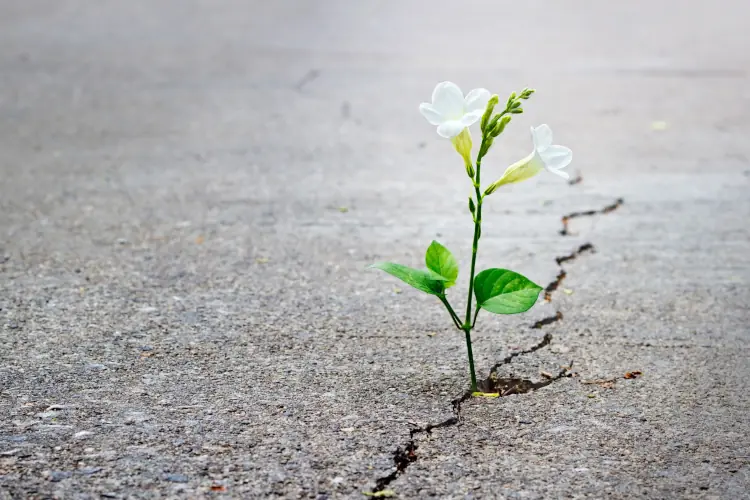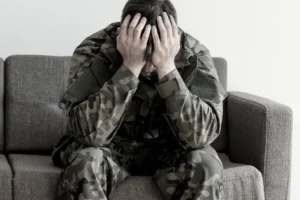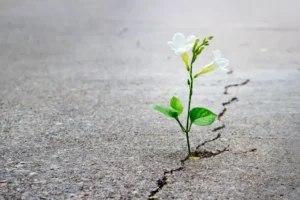Post-traumatic Growth

Trauma can cause lasting psychological wounds and even PTSD symptoms (nightmares, flashbacks shame etc.). But did you know that even highly traumatising experiences can be a catalyst for personal growth and development?
In this blog post, we’ll explore the concept of post-traumatic growth. Post-traumatic growth can happen, once we have successfully integrated the trauma and processed the stored traumatic memories through our body. Post-traumatic growth can be a fruitful source of inner meaning and strength.
Conditions for post-traumatic growth
Traumatic experiences can profoundly affect our ideas and believes about ourselves and the world. They can put us in a state where we see ourselves as wounded, helpless victims of other people or circumstances. Since trauma grips us on deep on the physical level of our body, cognitive reinterpretation of the event is not enough. Rather, it requires successful integration and processing of the trauma emotionally, physically, and at the level of meaning.
The following conditions are important to promote post-traumatic growth. Body psychotherapy approaches to trauma therapy offer a number of important tools to create these conditions.
Building Resources and Developing Resilience
The trauma has often shattered some of our resources – our body reacts differently and our confidence may be shaken. During the event we have given up and given in to the terrible experience. We lost our center and our impulses, our boundaries were violated. In the aftermath often social connections get lost.
Rebuilding individual resilience and a network that provides support from others are often important prerequisites for post-traumatic growth. This involves reconnecting to current reality. It also involves calming an overreactive and hypervigilant nervous system, rebuilding our boundaries and reconnecting back to our center and our impulses.
With support in therapy, resources can be rebuilt. – These include shutting down over-activation, rebuilding healthy boundaries, and returning to one’s center.
Processing of Emotions
Processing the strong emotions associated with trauma is often an important step back into balance.
- Initially, Anger and sadness about the experience or at other people are often in the foreground. In addition, there may be fear of a repetition of the experience. In addition, feelings of shame and guilt often have to be dealt with.
- Often, after the processing of superficial emotions, other emotions come into view, which enable a completely different self-experience.
- These emotions give way step by step to healthy self-compassion and compassion for others, as well as an awareness of inner strength and the current emotions in the here and now.
Processing old emotions makes it possible to feel more joy and connection, as well as to allow the emotions that are appropriate in the current situation.
Somatic Trauma Processing
Somatic processing of trauma means allowing the body to fully process and release the physical and emotional sensations associated with the trauma, rather than suppressing or avoiding them. This does not require reliving the trauma.
- In trauma therapy, techniques such as Somatic Experiencing or EMDR can be used. This allows you to access, process and release traumatic memories and sensations step-by-step and within a safe process.
- Aspects of the body being stuck in traumatic responses (fight, flight, freeze or collapse) can be unlocked, processed and released
By processing the trauma in the body, the body and mind move from high activation into a state of calmer relaxation. The individual can once again engage in spontaneous activity and connect socially with others.
Cognitive Trauma Processing
After the emotions associated with the trauma are processed and the shock energy states stored in the body are discharged, cognitive coping with the traumatic event becomes possible. Before that, a cognitively controlled reinterpretation of the traumatic experience is often laborious.
- A clear understanding of concepts such as “good” and “evil”, and appropriately placed responsibility can be developed. This makes it possible to place trauma in the continuum of human experience.
- Limiting beliefs about ourselves resulting from the trauma (e.g., “I am not worthy of being treated better”) or about the world (e.g. “the world is dangerous”) can be resolved.
- I no longer perceive myself as a passive victim of circumstances or events.
With that, I gain a new integrated sense of reality about myself. – I can accept what happened and that it cannot be undone. I can stop fighting the trauma and denying it to myself and others.
Once the trauma has been processed cognitively, it becomes possible to shape one’s life in the present more actively.
Aspects of post-traumatic growth
After the trauma has been processed, further positive changes become possible. This enables growth of the personality, not only despite the trauma, but also precisely through integration of the traumatic experience.
- Personality growth by overcoming trauma: By overcoming the trauma symptoms, openness for growth and new experiences become possible again. This becomes possible when the symptoms of PTSD (often straight withdrawal and avoidance behaviour) are successfully overcome.
- Personality growth through the trauma: Here it is a matter of bringing into consciousness and integrating the specific resources that were used in the shock event.
Actual post-traumatic growth (personality growth through trauma) is about achieving growth beyond the care of psychological wounds. This includes additional meaning-making and spiritual growth.
Post-traumatic growth does not mean undoing the trauma. Rather, it is integrating it in a new generative way.
Positive sense of purpose / new meaning of life
Trauma can shake an individual’s sense of meaning and purpose. Through post-traumatic growth, it becomes possible to learn additional lessons from trauma and find new meaning for life.
- New perspectives & values: The Trauma experience itself and the subsequent processing and integration of the trauma can prompt individuals to question their beliefs and values and develop new perspectives:
- This may lead to a reevaluation of what is truly important in life.
- This may involve developing a mindset / self-image of being able to overcome adversity and recognize personal strengths and resources.
- Meaning and direction of life: After successfully overcoming trauma, a stronger sense of purpose or meaning in one’s life may be developed.
- Examples: This may include
- a renewed commitment to personal values
- a sense of calling to help others who have experienced similar trauma.
- a shift in perspective towards a greater appreciation for the present moment
- a deepening of one’s sense of purpose and meaning of life.
One specific example would be psychologist Victor Frankl, who decided to talk after his survival about his experiences in German death camps. Something which helped him to survive the holocaust and develop his logo therapy. (Book recommendation: Victor Frankl, Man’s search for meaning).
Individual & spiritual growth
The experience of the shock-trauma itself and and the experience of overcoming it can serve as a trigger and catalyst for growth and transformation.
The shock-event itself, the aftermath and the therapy may allow us to live through extraordinary experiences. They allow us to encounter additional qualities within us and other people and the spiritual realm:
- During the shock-event itself, we may encounter extraordinary qualities within ourselves and others
- Access to Survival Instincts: During the shock, time may appear to slow down or we seem to have access to unusual powers to survive.
- Access to Higher Self: During the shock there may be moments where consciousness is thrown out of the body / we can seemingly observe ourselves from a observing position
- Extraordinary human beings: Experiencing extraordinary qualities in other people
- During the aftermath of the shock-event, we may encounter extraordinary qualities particularly from and with other people
- There may be experiences of community among the survivors
- There may be people who care for us after the event – seemingly unexpected – e.g. a smiling face, a helping hand, somebody giving us a hug
- There may be the elation of having survived the event
- We may notice that we are carried by others through the event – by other people or something like God or Spirit.
- When we release the trauma in therapy or spontaneously, this may be associated with peak emotional and spiritual experiences
- Developing Self-Compassion – We can feel an extraordinary amount of compassion for ourselves.
- Being carried – We can recognize that we were somehow carried by the event – by other people or by something like God or the Spirit of the Universe
- Spiritual Peak Experience – At the same time, experiences of connectedness with a greater whole / God or the universe are often part of a transformational experience
These experiences can help connect to something greater than oneself, be it a higher power, the natural world, or a sense of universal connectedness.
Furthermore, spiritual growth can take many forms in the aftermath of trauma. For some, it may involve a deepening of their existing religious or spiritual beliefs, as they turn to faith as a source of comfort and strength in difficult times or feel grateful having survived the event. Others may start as part of their search for support / therapy new spiritual practices or beliefs that resonate with them, such as mindfulness meditation or yoga.
The reintegration of trauma experiences can lead to spiritual growth. We can connect to something greater than oneself, whether it is a higher power, the natural world, or a sense of universal connectedness.
Integration into life story & identity
One’s sense of identity encompasses one’s life story, self-perception, understanding of one’s place in the world, and how one relate to others. Identity evolves and adapts over time in response to various life events, including the experience of trauma, the processing of trauma and the subsequent post-traumatic growth.
Through the course of trauma processing and post-traumatic growth, you can reevaluate and reshape their beliefs about themselves. This allows you to accept the shock event as a past experience and place it differently in your life story.
You can challenge and transform negative self-perceptions that may have been influenced by the traumatic experience. You can move not only beyond a victim mentality, but start cultivating new beliefs that emphasize resilience, self-worth, and personal agency. This shift in beliefs about yourself contributes to healthier and more empowered sense of identity.
By accepting the traumatic experience and integrating it into one’s life story & identity, the individual sense of reality and congruence of identity can be restored.
Opportunity Post-traumatic growth
There is no guarantee for post-traumatic growth. Pre-requisites for post traumatic growth are rebuilding safety, processing emotions and trauma in the body, cognitive reevaluation and reintegration of the trauma into the life story and identity. By working through these components, individuals can transform their trauma into a catalyst for personal growth and development. Such growth in meaning and identity is often also an important aspect in overcoming the symptoms of PTSD.
Therefore, it is possible for people to emerge from difficult experiences not only more resilient, but also more positive and more fulfilled in their lives. This may include additional competencies, new meaning in life and spiritual growth. Some of this growth is made possible by the trauma in the first place.
Ultimately new perspectives, changed values and believes and spiritual growth can profoundly affect our believes about ourselves and our self-perception. Psychotherapy can help alleviate the symptoms of PTSD and support additional positive growth.









